Review: The Smithsonian African American Museum Is Here at Last. And It Uplifts and Upsets.
New York Times: WASHINGTON — On a late summer day in 1963, 200,000 Americans made the Washington Monument the compass needle for a new direction in history, up and forward, when they gathered at its base, then marched a mile or so on to hear the Rev. Dr. Martin Luther King Jr. preach — sing, really — a sermon on racism and a dream of change.
On an early autumn day (this) week, just yards from the monument, the compass itself will, symbolically speaking, become fully visible, when the National Museum of African American History and Culture opens to the public. To paraphrase the preacher: It’s here at last, here at last. And it’s more than just impressive. It’s a data-packed, engrossing, mood-swinging must-see.
Rising in three low, inverted-pyramid tiers, the building occupies what had been the last undeveloped museum site on the National Mall. Its design, by the Tanzanian-born British architect David Adjaye, is unlike any of the others. They are of white or buff stone or concrete; this one, covered in metal panels, is a deep black-brown. The other museums reflect light; this one absorbs it, making it look, despite its size, discreet and recessive, about silhouette rather than bulk. (read more)
Related: Why the African American History museum’s cafe will serve son-of-a-gun stew and other unexpected dishes
Of course, you’ll find Hoppin’ John and Brunswick stew and buttermilk fried chicken and barbecue on the menu at the National Museum of African American History and Culture’s Sweet Home Cafe. But you’ll find unexpected dishes, too: Son-of-a-gun stew. Pan-roasted oysters. Smoked haddock and corn croquettes with a gribiche sauce.
Just as the museum’s food exhibitions aim to tell the story of African American cooking beyond soul food, so too does the Sweet Home Cafe. In a way, it’s like another exhibition. (read more)
Music from Baylor gospel project to be featured in Smithsonian’s new African-American museum
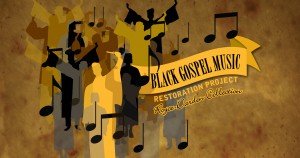 Many of the black gospel recordings that Baylor University professor Bob Darden has championed in his career tell their listeners that patience, faith and endurance on the journey will lead to a reward.
Many of the black gospel recordings that Baylor University professor Bob Darden has championed in his career tell their listeners that patience, faith and endurance on the journey will lead to a reward.
For Darden, Baylor’s Black Gospel Music Restoration Project and their staffers and supporters, one of those rewards comes this month when the Smithsonian Institution’s National Museum of African-American History in Washington, D.C., opens to the public Sept. 24.
Included in the new museum’s Music Crossroads is an interactive touch screen in the museum’s permanent exhibit that will play selections and provide information from the Baylor black gospel music collection. (read more, listen to audio clips)
George Washington’s African-American descendants recognized after 200 years
The president’s adopted son, who went by ‘Wash,’ likely fathered children with slaves. Now, historians are granting his living descendants the proper recognition.
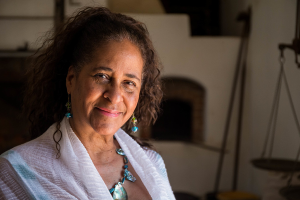 Rumors that have surrounded George Washington’s family tree for more than 200 years have been confirmed: Since some of the nation’s earliest days, the Founding Father and first US president’s family tree has had biracial members.
Rumors that have surrounded George Washington’s family tree for more than 200 years have been confirmed: Since some of the nation’s earliest days, the Founding Father and first US president’s family tree has had biracial members.
The National Park Service and the nonprofit that runs Washington’s Mount Vernon estate have added exhibits to the estate that recognize descendants of Washington’s step-grandson who were born outside of the official family lineage. While no DNA evidence has been used to back up the claims, historians say the rumors have long lived in the shadows of the classic perceptions of the first family, and they now have other evidence that’s sufficient to make the call.
“There is no more pushing this history to the side,” Matthew Penrod, a National Park Service ranger and programs manager at Arlington House, the former home of Robert E. Lee, told the Associated Press. (Read more, see video)
Pictured: ZSun-nee Miller-Matema poses for a portrait at Mount Vernon, the plantation home of former US President George Washington, in Alexandria, Va. Miller-Matema is a descendent of Caroline Branham, one of George Washington’s slaves who served as former first lady Martha Washington’s personal maid. The National Park Service and the nonprofit that runs the historic Mount Vernon estate are acknowledging an aspect of US history that doesn’t show up in most textbooks: The family tree of America’s first family has been biracial from its earliest branches. Photo: Zach Gibson/AP
TIPHC Bookshelf
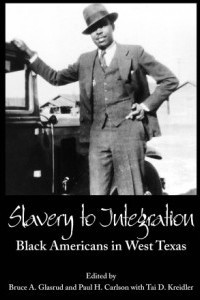 Published scholarship on black history in Texas is growing and we’d like to share with you some suggested readings, both current and past, from some of the preeminent history scholars in Texas and beyond. We invite you to take a look at our bookshelf page — including a featured selection — and check back as the list grows. A different selection will be featured each week. We welcome suggestions and reviews. This week, we offer, “Slavery to Integration, Black Americans in West Texas,” edited by Bruce A. Glasrud, Paul H. Carlson and Tai D. Kreidler.
Published scholarship on black history in Texas is growing and we’d like to share with you some suggested readings, both current and past, from some of the preeminent history scholars in Texas and beyond. We invite you to take a look at our bookshelf page — including a featured selection — and check back as the list grows. A different selection will be featured each week. We welcome suggestions and reviews. This week, we offer, “Slavery to Integration, Black Americans in West Texas,” edited by Bruce A. Glasrud, Paul H. Carlson and Tai D. Kreidler.
Black Americans arrived in West Texas in the early sixteenth century and nearly five centuries later continue to contribute to the region that shares so many characteristics with the western United States. Despite that distinguishing feature, no published study covers the lives of African Americans in West Texas. This volume, Slavery to Integration: Black Americans in West Texas, seeks to fill that gap. Slavery to Integration consists of twelve articles depicting the basic themes and topics of the black American experience in West Texas.
This Week In Texas Black History, Sep. 18-24
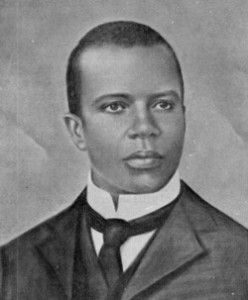 18 – On this day in 1899, a copyright was registered for Scott Joplin‘s “Maple Leaf Rag.” The Texarkana native’s ragtime composition for piano is his best known piece. More than a million copies of the tune’s sheet music was sold encouraging the publication of hundreds of similar pieces as a ragtime craze swept the country. Joplin’s piece was the genre’s biggest hit and became the model for ragtime compositions. The name of the tune was derived from the Sedalia, Mo. social club, the Maple Leaf, where Joplin played. The piece gave Joplin a steady if unspectacular income for the rest of his life.
18 – On this day in 1899, a copyright was registered for Scott Joplin‘s “Maple Leaf Rag.” The Texarkana native’s ragtime composition for piano is his best known piece. More than a million copies of the tune’s sheet music was sold encouraging the publication of hundreds of similar pieces as a ragtime craze swept the country. Joplin’s piece was the genre’s biggest hit and became the model for ragtime compositions. The name of the tune was derived from the Sedalia, Mo. social club, the Maple Leaf, where Joplin played. The piece gave Joplin a steady if unspectacular income for the rest of his life.
Listen to the song here.
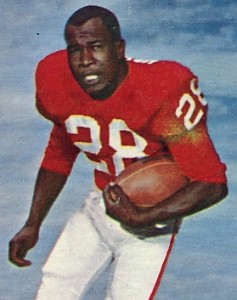 19 – Former Dallas Texans and Kansas City Chiefs running back Abner Haynes was born on this day in 1937 in Denton. In 1956, Haynes and Leon King became the first African-American student athletes at North Texas State College (now North Texas State University). In 1960, Haynes, a graduate of Dallas Lincoln High School, joined the Texans in the first season for the American Football League and led the league in rushing attempts, yards, and TDs in its first year and was the league’s first Player of the Year and Rookie of the Year. Haynes had an eight-year career and still owns several Chiefs’ franchise records. His 12,065 combined yards is the AFL record.
19 – Former Dallas Texans and Kansas City Chiefs running back Abner Haynes was born on this day in 1937 in Denton. In 1956, Haynes and Leon King became the first African-American student athletes at North Texas State College (now North Texas State University). In 1960, Haynes, a graduate of Dallas Lincoln High School, joined the Texans in the first season for the American Football League and led the league in rushing attempts, yards, and TDs in its first year and was the league’s first Player of the Year and Rookie of the Year. Haynes had an eight-year career and still owns several Chiefs’ franchise records. His 12,065 combined yards is the AFL record.
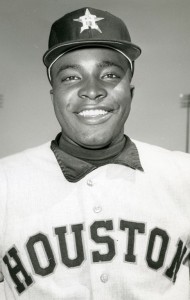 19 – On this day in 1943, baseball player Joe Morgan was born in Bonham. A second baseman, Morgan grew up in Oakland, Calif. In 22 seasons in Major League Baseball, Morgan had 2,517 hits, 268 home runs, 1,133 RBIs, 1,650 runs, 689 stolen bases, and a .271 batting average. His 266 home runs as a second baseman broke Rogers Hornsby’s record for most home runs by a player at that position. In 1965, Morgan’s first full season in the majors, he was named the NL Rookie of the Year for the Houston Astros; he hit 14 home runs, scored 100 runs, and had a .271 batting average. With the Cincinnati Reds, Morgan made the All-Star team during each of his eight seasons and received five Gold Gloves for fielding excellence. He was NL MVP in 1975 and 1976 when he led the Reds to back-to-back World Series championships. He was elected to the Baseball Hall of Fame in 1990.
19 – On this day in 1943, baseball player Joe Morgan was born in Bonham. A second baseman, Morgan grew up in Oakland, Calif. In 22 seasons in Major League Baseball, Morgan had 2,517 hits, 268 home runs, 1,133 RBIs, 1,650 runs, 689 stolen bases, and a .271 batting average. His 266 home runs as a second baseman broke Rogers Hornsby’s record for most home runs by a player at that position. In 1965, Morgan’s first full season in the majors, he was named the NL Rookie of the Year for the Houston Astros; he hit 14 home runs, scored 100 runs, and had a .271 batting average. With the Cincinnati Reds, Morgan made the All-Star team during each of his eight seasons and received five Gold Gloves for fielding excellence. He was NL MVP in 1975 and 1976 when he led the Reds to back-to-back World Series championships. He was elected to the Baseball Hall of Fame in 1990.
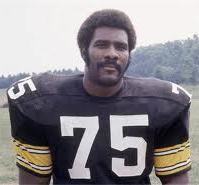 24 – On this day in 1946, football great Charles Edward Greene , “Mean Joe,” was born in Temple, Texas. Greene starred at Dunbar High School, then became an All-American lineman in 1968 at North Texas State University. Greene (6-4, 275 pounds) was the Pittsburgh Steelers No. 1 pick in the 1969 National Football League draft and was a dominant force on the Steelers’ four Super Bowl championship teams the 1970s as leader of their “Steel Curtain” defense. He was NFL Defensive Rookie of the Year in 1969, played in 10 Pro Bowls, was All-NFL five times, and NFL Defensive Player of the Year in 1972 and 1974. He was inducted to the Pro Football Hall of Fame in 1987.
24 – On this day in 1946, football great Charles Edward Greene , “Mean Joe,” was born in Temple, Texas. Greene starred at Dunbar High School, then became an All-American lineman in 1968 at North Texas State University. Greene (6-4, 275 pounds) was the Pittsburgh Steelers No. 1 pick in the 1969 National Football League draft and was a dominant force on the Steelers’ four Super Bowl championship teams the 1970s as leader of their “Steel Curtain” defense. He was NFL Defensive Rookie of the Year in 1969, played in 10 Pro Bowls, was All-NFL five times, and NFL Defensive Player of the Year in 1972 and 1974. He was inducted to the Pro Football Hall of Fame in 1987.
Blog: Ron Goodwin, author, PVAMU history professor
Ron Good  win’s bi-weekly blog appears exclusively for TIPHC/TBHPP. Goodwin is a San Antonio native and Air Force veteran. Generally, his column will address contemporary issues in the black community and how they relate to black history. He and the TIPHC/TBHPP staff welcome your comments. His latest blog is, “Race Matters, or, What the hell do I have to lose?” Read it
win’s bi-weekly blog appears exclusively for TIPHC/TBHPP. Goodwin is a San Antonio native and Air Force veteran. Generally, his column will address contemporary issues in the black community and how they relate to black history. He and the TIPHC/TBHPP staff welcome your comments. His latest blog is, “Race Matters, or, What the hell do I have to lose?” Read it
Submissions Wanted
Historians, scholars, students, lend us your…writings. Help us produce the most comprehensive documentation ever undertaken for the African American experience in Texas. We encourage you to contribute items about people, places, events, issues, politics/legislation, sports, entertainment, religion, etc., as general entries or essays. Our documentation is wide-ranging and diverse, and you may research and write about the subject of your interest or, to start, please consult our list of suggested biographical entries and see submission guidelines. However, all topics must be approved by TIPHC/TBHPP editors before beginning your research/writing.
We welcome your questions or comments via email or telephone – mdhurd@pvamu.edu.
